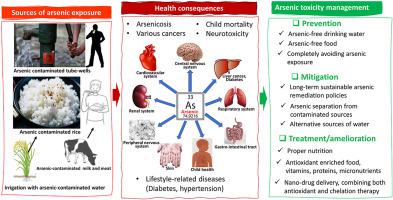Environmental Pollution ( IF 7.6 ) Pub Date : 2021-08-10 , DOI: 10.1016/j.envpol.2021.117940
Md Shiblur Rahaman 1 , Md Mostafizur Rahman 2 , Nathan Mise 3 , Md Tajuddin Sikder 4 , Gaku Ichihara 5 , Md Khabir Uddin 2 , Masaaki Kurasaki 6 , Sahoko Ichihara 3

|
Arsenic is a well-recognized environmental contaminant that occurs naturally through geogenic processes in the aquifer. More than 200 million people around the world are potentially exposed to the elevated level of arsenic mostly from Asia and Latin America. Many adverse health effects including skin diseases (i.e., arsenicosis, hyperkeratosis, pigmentation changes), carcinogenesis, and neurological diseases have been reported due to arsenic exposure. In addition, arsenic has recently been shown to contribute to the onset of non-communicable diseases, such as diabetes mellitus and cardiovascular diseases. The mechanisms involved in arsenic-induced diabetes are pancreatic β-cell dysfunction and death, impaired insulin secretion, insulin resistance and reduced cellular glucose transport. Whereas, the most proposed mechanisms of arsenic-induced hypertension are oxidative stress, disruption of nitric oxide signaling, altered vascular response to neurotransmitters and impaired vascular muscle calcium (Ca2+) signaling, damage of renal, and interference with the renin-angiotensin system (RAS). However, the contributions of arsenic exposure to non-communicable diseases are complex and multifaceted, and little information is available about the molecular mechanisms involved in arsenic-induced non-communicable diseases and also no suitable therapeutic target identified yet. Therefore, in the future, more basic research is necessary to identify the appropriate therapeutic target for the treatment and management of arsenic-induced non-communicable diseases. Several reports demonstrated that a daily balanced diet with proper nutrient supplements (vitamins, micronutrients, natural antioxidants) has shown effective to reduce the damages caused by arsenic exposure. Arsenic detoxication through natural compounds or nutraceuticals is considered a cost-effective treatment/management and researchers should focus on these alternative options. This review paper explores the scenarios of arsenic contamination in groundwater with an emphasis on public health concerns. It also demonstrated arsenic sources, biogeochemistry, toxicity mechanisms with therapeutic targets, arsenic exposure-related human diseases, and onsets of cardiovascular diseases as well as feasible management options for arsenic toxicity.
中文翻译:

环境砷暴露及其对人类疾病的贡献、毒性机制和管理
砷是一种公认的环境污染物,通过含水层中的地质过程自然产生。全世界有超过 2 亿人可能暴露于砷含量升高的环境中,这些人主要来自亚洲和拉丁美洲。据报道,砷暴露会导致许多不利的健康影响,包括皮肤病(即砷中毒、角化过度、色素沉着变化)、致癌作用和神经系统疾病。此外,最近已证明砷会导致非传染性疾病的发生,例如糖尿病和心血管疾病。砷诱发糖尿病的机制是胰腺 β 细胞功能障碍和死亡、胰岛素分泌受损、胰岛素抵抗和细胞葡萄糖转运减少。然而,2+) 信号、肾脏损伤和干扰肾素-血管紧张素系统 (RAS)。然而,砷暴露对非传染性疾病的影响是复杂和多方面的,关于砷诱发的非传染性疾病的分子机制的信息很少,也没有确定合适的治疗靶点。因此,未来需要进行更多的基础研究,以确定适当的治疗靶点,用于砷诱导的非传染性疾病的治疗和管理。几份报告表明,每日均衡饮食和适当的营养补充剂(维生素、微量营养素、天然抗氧化剂)已显示有效减少砷暴露造成的损害。通过天然化合物或营养食品进行砷解毒被认为是一种具有成本效益的治疗/管理方法,研究人员应关注这些替代方案。这篇评论论文探讨了地下水中砷污染的情景,重点是公共卫生问题。它还展示了砷的来源、生物地球化学、具有治疗靶点的毒性机制、砷暴露相关的人类疾病和心血管疾病的发病以及砷毒性的可行管理方案。

































 京公网安备 11010802027423号
京公网安备 11010802027423号